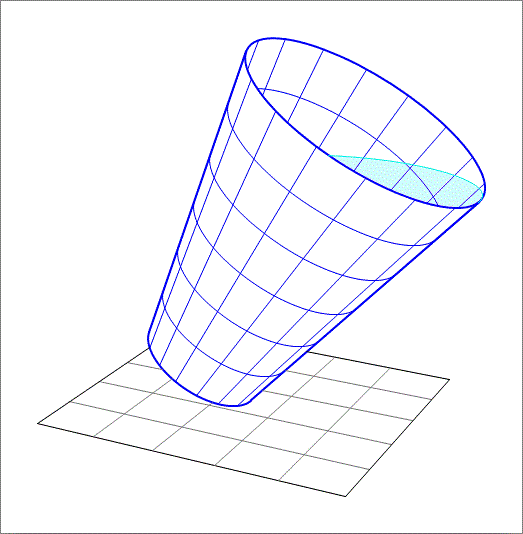Poured out water - conical cup

A cup is filled to its top with water. The cup is a conical frustrum with bottom radius cm, and top radius cm, and slant height cm. It is slowly tilted by . Find the volume of water (in cubic centimeters) that has been poured out.
Details and Assumptions:
- You may need the following formulas for the semi-minor and semi-major axes lengths of the water surface ellipse.
Where is the distance between the apex and the intersection point of the axis with the intercepting plane. is the semi-vertical angle of the cone, i.e. the angle between the axis of the cone and its surface. Finally, is the acute angle between the axis of the cone and the normal vector to the intersecting plane. For completeness (although you won't need this in this problem), the distance between the center of the ellipse and the point where the axis of the cone meets the cutting plane is given by ,
These formulas were derived in the solution of this problem .
The answer is 98.16.
This section requires Javascript.
You are seeing this because something didn't load right. We suggest you, (a) try
refreshing the page, (b) enabling javascript if it is disabled on your browser and,
finally, (c)
loading the
non-javascript version of this page
. We're sorry about the hassle.
Align the axis of the conical frustrum along the x -axis with the point of water surface farthest from the brim on the z -axis as shown. Then the volume of water poured out is the volume between the internal wall of the frustrum and the water surface.
For a value of x , a slice δ x of this poured water has a surface cross-section of a segment of a circle of radius r with the base of the segment distance h from the center of the circle or the x -axis. Let 2 θ = cos − 1 ( r h ) . Then the cross-sectional area A = r 2 cos − 1 ( r h ) − h r 2 − h 2 and the volume of the poured water is given by:
V = ∫ 0 l ( r 2 cos − 1 ( r h ) − h r 2 − h 2 ) d x
where l is the horizontal distance between the brim and the z -axis (red dash line). We note that the gradient of the slanting side of the frustrum m = 1 0 2 − 2 2 2 = 2 6 1 . Consider the diameter of the brim
m l + l cot 3 0 ∘ ⟹ l = 8 = 2 6 1 + 3 8 = 1 + 6 2 1 6 6
We note that r ( x ) is given by the top black line
r ( x ) r ( 0 ) ⟹ r = m x + z 0 = z 0 = 4 − m l = m ( x − l ) + 4 where z 0 is the z -intercept.
And h ( x ) is given by the blue line (water surface) h = 4 − m l − 3 x . With r , h , and l known we can perform the integration (of course not by hand) to find V . I used a simple Python code and the answer is 9 8 . 1 6 .